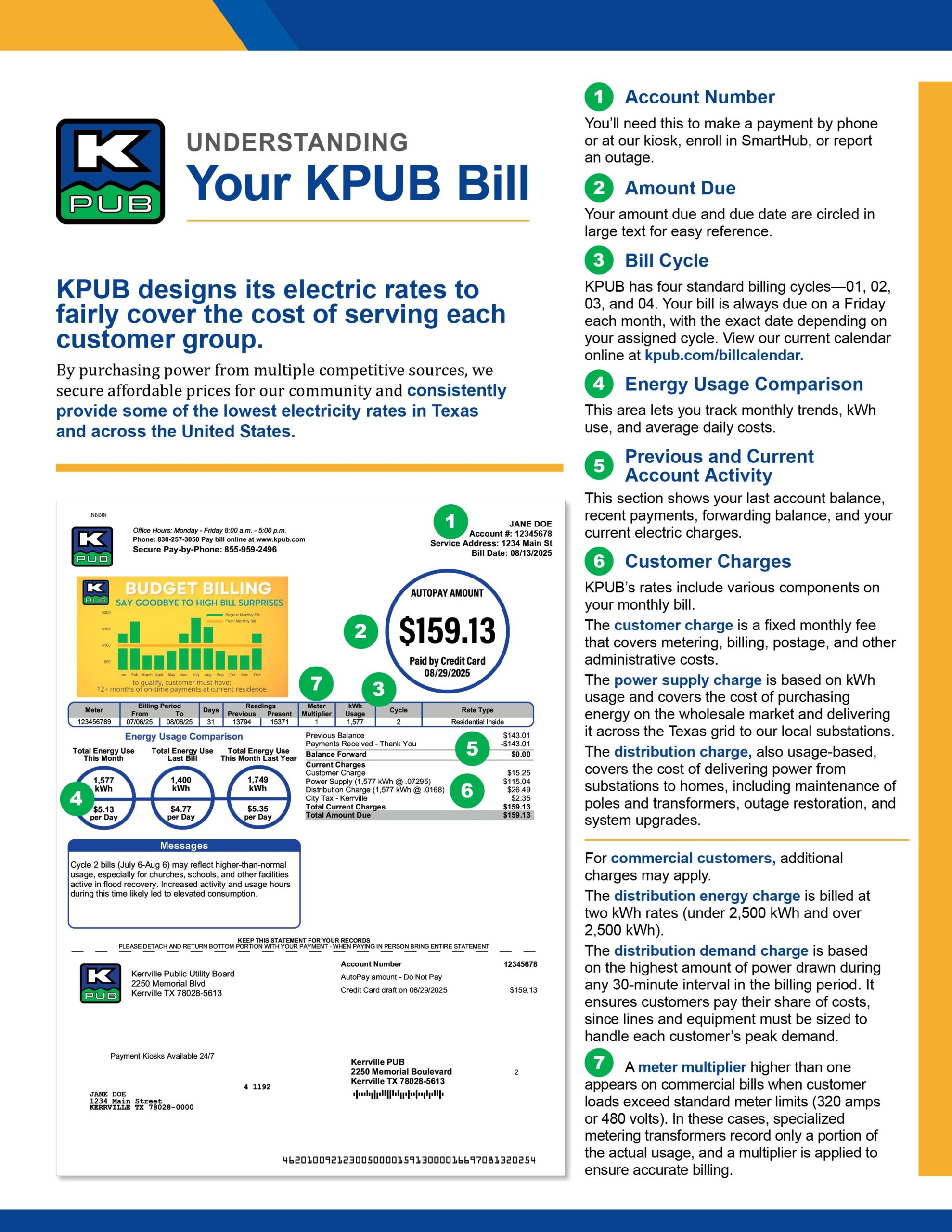Understanding your KPUB bill
Residential Customers
Our residential rate structure is comprised of three components that will appear under the detail of electric charges on your monthly bill: power supply charge, distribution charge and customer charge.
Power supply charge
The first component is the power supply charge that’s also based on energy consumption or kWh usage. This charge covers the cost to purchase energy on the wholesale ERCOT market and deliver that energy across the statewide transmission grid to our local substations.
Distribution charge
The second component is the distribution charge that varies based on how much energy (or kilowatt-hours (kWh)) a customer uses. This charge covers the cost to distribute power from one of our nine local substations to the customer’s home.
This includes the costs of:
- Maintenance to equipment like poles, wires and transformers,
- Operational activities to keep the system running and restore outages, and
- Construction activities to replace aging equipment, increase system capacity and/or improve reliability.
Customer charge
The third component is the customer charge. It is a fixed monthly charge that covers our costs for metering and billing an account. Billing includes data processing, calculating and printing bills, postage, and other administrative costs.
Commercial Customers
Our commercial rate structure is comprised of four components that will appear under the detail of electric charges on your monthly bill: power supply charge, distribution energy charge, distribution demand charge and customer charge.
Power supply charge
The first component is the power supply charge, which is also based on energy consumption or kWh usage. This charge covers the cost to purchase energy on the wholesale ERCOT market and deliver that energy across the statewide transmission grid to our local substations.
Distribution energy charge
The second component is the distribution energy charge, which varies based on the amount of energy (or kilowatt-hours (kWh)) a customer uses. This charge covers part of the cost to distribute power from one of our nine local substations to the customer’s home.
This includes the costs of:
- Maintenance of equipment like poles, wires and transformers,
- Operational activities to keep the system running and restore outages, and
- Construction activities to replace aging equipment, increase system capacity and/or improve reliability.
The distribution energy charge is billed at two different kWh rates for usage:
- less than 2500 kWh
- greater than 2500 kWh
Distribution demand charge
The third component is the distribution demand charge. This charge is based upon the highest amount of power drawn during any 30-minute interval during the billing period.
This charge helps to ensure that low energy usage customers pay their fair share of the costs to serve them because the lines and equipment used to serve customers are sized based on the highest amount of power drawn by the customer.
Customer charge
The fourth component is the customer charge. It is a fixed monthly charge that covers our costs for metering and billing an account. Billing includes data processing, calculating and printing bills, postage, and other administrative costs.
Meter Multiplier
A meter multiplier higher than one appears on commercial bills when customer loads exceed standard meter limits (320 amps or 480 volts). In these cases, specialized metering transformers record only a portion of the actual usage, and a multiplier is applied to ensure accurate billing.
Billing & Due Dates
At KPUB, we want to make it simple for you to know when your bill is due and how to avoid late fees.
When Your KPUB Bill Is Due
-
- KPUB uses four standard billing cycles: cycle 1, cycle 2, cycle 3, and cycle 4.
- Bills are always due on a Friday each month.
- Bills are due upon arrival. It becomes past due 16 days after it is unpaid.
- Your specific due dates depend on your assigned bill cycle.
Late Fees
-
A one-time penalty of 5% is added to the unpaid balance if your bill becomes past due.
-
Senior customers age 60 and over: Late penalties are waived with proof of age.
View all your due dates for the year, organized by your billing cycle by clicking the button below!
Changing Your Billing Cycle
If you’d like to select a billing cycle that works better for your pay schedule or budget, we are happy to change your cycle! Contact our customer service department at 830.257.3050 or email [email protected].
*please note, you can only change your billing cycle once a year.

